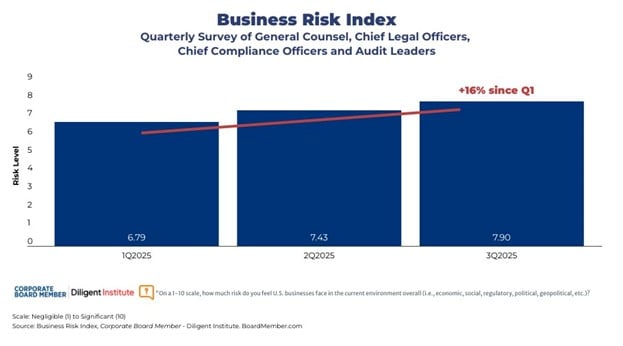 Nowhere is the speed of the digital world more evident than when a company tilts into decline from a combination of negative events (irrespective of whether it is of their own making or not), bad word-of-mouth, and/or bad financial performance.
Nowhere is the speed of the digital world more evident than when a company tilts into decline from a combination of negative events (irrespective of whether it is of their own making or not), bad word-of-mouth, and/or bad financial performance.
As news speeds across channels and verticals with real-time impacts across all stakeholders, there is precious little opportunity to begin planning a response. In 2019 and beyond, a board’s reflexes need to be finely honed—and that means throwing out the standard drill for response and remediation.
We share the key perspectives from the financial, marketing and communication perspective that must be held in the first hours and days of a crisis if leadership is going to successfully navigate the turbulent waters of 21st Century reputational challenges and brand pressure.
The Peacetime Preparation for a Lightning Counterattack on Bad Financial News
In today’s short-attention-span, clickbait media culture, a good guy/bad guy narrative related to stock price dives, unwanted attention by regulators, product recalls, data breaches, allegations of executive malfeasance, downgrades by analysts, etc., will be circulated quickly and set like cement.
The best defense is to already have been proactive. Short of that, authentic strategic actions are required. There was a time when a blanket statement would buy you a few days while you conferred with ops, technical and legal staff to do fact-finding and formulate a response to minimize the feeding frenzy. Or to huddle amongst the board and figure out the magnitude of the problem. These are luxuries of a bygone era. (Just ask Boeing, who just could not keep up with the carnivorous news cycles related to the woes of the 737 Max 8.)
Every minute spent after bad news breaks must be dictated by an extremely disciplined protocol determined months in advance, “red teamed” to anticipate for weakness, and orchestrated down to the last detail. With an agreed-upon corporate crisis team that includes expertise that represents all of the organization’s stakeholders, the crisis management process begins immediately. The gravity of the crisis will not be subject to endless dithering; it will be quickly located on a severity matrix that has objective and agreed-to criteria that determine the nature and level of the response, who is to be notified and who’s involved in the decision making process—with clear trigger points for when the crisis team will consider the situation escalated or deescalated.
Takeaway
The standard for preparation in the face of events that negatively impact the organization is to have a detailed counterattack plan—implemented without hesitation—before the close of business on Crisis Day One. This preparation has an exponential payoff and can be the difference between a company’s value taking a minor ding or cratering completely.
Get a Fast and Accurate Read on Your True Reputation
Assuming that the C-suite and board share the view that their company is truly on Crisis Response: Day 1, one of the most important quantitative weapons in your response will be a measure of how bad the damage is.
The bad news? The news items that have hit the board’s radar are only the tip of a massive online iceberg that is creating your true reputation score—by this we mean a mathematically defensible ranking of the relevance, credibility, visibility and leverage of your online brand.
The good news? This can all be measured down to the pixel. While a less-informed board might demand that expensive, high-level PR or marketing resources be thrown at a handful of high-profile negative assets, today’s digital methodology quickly gives you a leadership dashboard that takes into account Google’s complex inner workings to give you an accurate up-to-the-day measurement on the real KPIs you need to hit to:
• Stop the high-level brand equity damage
• Address specific negative assets that degrade your Google rank, your current customers’ propensity to stay with you, and prospects’ likelihood to believe and buy
That which can be measured can be acted upon. A board that has a metrically defensible remediation plan in hand in the first 30 days is miles ahead of the board that doesn’t.
Takeaway
The true impact of your company’s reputation on your brand and earnings is hidden from you and throwing your marketing budget at Google Adwords trying to buy up the bad terms is a waste. You should have a granular picture of your reputation and both a crisis and mid/long-term remediation plan in hand.
Calming and Stabilizing Your Complicated World of Stakeholders in the Next 30 Days
Rome wasn’t built in a day, but in the age of digital media, it can be practically be torn down in one. A spate of terrible coverage from tier-one publications means people can read about your troubles for decades when they Google you.
To make this harder? Few senior board members have ever had to guide their organizations through an honest-to-God, 21st Century reputation crisis, which begins in fifth gear and gets faster from there. Huddling with counsel and doing some kind of damage control worked great when stakeholder groups were more siloed, but today you have customers, clients, partners, competitors and investors all inhaling and sharing the bad news, and you’ve got to make a prioritized plan about how to talk to all of them at once.
After resources have been deployed to triage the situation (as suggested by my colleague’s advice above), your focus moves to a slightly longer, but still critical horizon: the next 30 days of crisis mode. Here are things that you should anticipate being able to handle:
• Do not be caught flatfooted by the velocity and response of business partners and associates. The confidentiality you asked for will be violated by someone, and these actors will spread bad news the fastest because they have insider credibility.
• Be proactive: one of the top tasks of your working executive team is to identify additional weaknesses and strengths inside the organization so you’re not stuck in reactive mode, trying to stop a chain reaction.
• Aggressively communicate operational continuity: Everybody from your rank-and-file to the Street needs to hear that, for your company, it’s 99% (or whatever percentage you can guarantee) business as usual. This will go a long way toward dampening continuing bad news cycles and boosting morale.
Takeaway
Plan for obvious challenges—and some counterintuitive ones—so the first month of your response addresses the busy intersection of speculation that can prolong your woes.
Conclusion
The speed at which your company’s fortunes can turn south rivals cinematic pace in the 21st Century. And blood in the water spreads faster and does more damage than ever before. C-suite and board response from Days 1-30 days will require battle-hardened, unsentimental views of the problem from the investor, marketing and PR standpoints if you are to limit the damage—and maybe even preserve your seat on the board so you can be known as one of the team that righted the ship and not one of those who were swept overboard in the first wave.
Read more: Employee Advocacy on Environmental and Social Issues: Are Your Board and Management Team Prepared?



